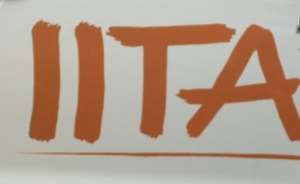
Increasing the quota of women in research transcends the clamor for gender mainstreaming; it is all about improving productivity and efficiency, says IITA Director General, Dr Nteranya Sanginga.
He says the need to increase the population of women in IITA is driven by the productivity of women staff which had proven to be above their male counterparts over the years.
Citing an instance at the Threshing Building— a unit involved in the threshing of crops such as maize, soybean, cowpea, and rice―Dr Sanginga said out of a workforce of over 100 in that unit, 30 percent are women, but in terms of output, they account for more than 70 percent.
“Another example that comes to mind is the IITA Women's Group that is involved in charitable programs including donations to orphanages, community development, and the provision of scholarships,” he said.
The Director General described the women workforce as productive but yet to be fully tapped resource.
Making the vision a reality
But more than increasing the numbers of women, Dr Sanginga said that he envisioned more women in management of the Institute in the years ahead.
He called on women to come out of their shells and aspire for higher positions.
“You need to be excellent in whatever you are doing... You need to be innovative,” he said.
But like elsewhere, challenges abound that limit the performance of the women folk. For instance, several young working mothers have children and husbands to take care of. For many, taking higher positions that would compromise the care of their children is a non-starter.
Another challenge is the cultural perception which sees women as weaker vessels and has cast a shadow of an inferiority complex on women, especially in the African context. In this wise some women see some jobs as “no go areas for them” and in some cases the Human Resources Unit is compelled to invite only men as women don't apply.
This is why Dr Sanginga charged the women: “Apply for positions... Don't be shy.”
Delivery is key
As positive sentiment across several organizations to increase the quota of women grows, several organizations have different propositions to address this challenge of low populations of women.
In IITA, the key is for women to muster more courage than ever before and participate in project execution to ensure that IITA meets its delivery goals. “If we are able to meet our delivery targets, I will not hesitate to employ more women. But if we fail to meet our project execution targets, we will have no option but to downsize,” Dr Sanginga said.
In less than 2 years, IITA has doubled its annual budget and there are still prospects for growth.
Dr Sanginga said the energy from the women is needed now to ensure that the Institute meets its obligations, emphasizing that “if you (women) take care of IITA, IITA will take care of you.”
In response to the call for greater participation of women and to be able to fill top management positions in IITA, some women called for policies that would enable them to further their education while at the same time keep their jobs and take care of their babies.
“We need to further our education,” Mrs Kafilat Odesola, IITA Scientist, said, emphasising that such opportunities would not compromise research, “because women can multitask and do a hundred things at the same time.”
The women staff set up a committee to map out an implementation strategy to increase the workforce of women, and advise on matters relating to staff promotions in IITA.
The committee, which has strong institutional backing, plans to raise the number of women staff by 50 percent over the next 3 years.




 Supreme court declares payment of wages to spouses of President, Vice President ...
Supreme court declares payment of wages to spouses of President, Vice President ...
 Publish full KPMG report on SML-GRA contract – Bright Simons to Akufo-Addo
Publish full KPMG report on SML-GRA contract – Bright Simons to Akufo-Addo
 Kumasi International Airport to begin full operations by end of June
Kumasi International Airport to begin full operations by end of June
 Election 2024: Our ‘real challenge’ is getting ‘un-bothered’ youth to vote – Abu...
Election 2024: Our ‘real challenge’ is getting ‘un-bothered’ youth to vote – Abu...
 [Full text] Findings and recommendations by KPMG on SML-GRA contract
[Full text] Findings and recommendations by KPMG on SML-GRA contract
 Renegotiate SML contract – Akufo-Addo to GRA, Finance Ministry
Renegotiate SML contract – Akufo-Addo to GRA, Finance Ministry
 J.B Danquah-Adu murder trial: Sexy Dondon to Subpoena Ken Agyapong, Ursula Owusu
J.B Danquah-Adu murder trial: Sexy Dondon to Subpoena Ken Agyapong, Ursula Owusu
 Galamsey: Five Burkinabes jailed 20 years each for mining
Galamsey: Five Burkinabes jailed 20 years each for mining
 'It's no crime' – Abu Sakara defends Alan's exit from NPP
'It's no crime' – Abu Sakara defends Alan's exit from NPP
 'We know all your houses, pay your bills now or we’ll disconnect you; we're all ...
'We know all your houses, pay your bills now or we’ll disconnect you; we're all ...
